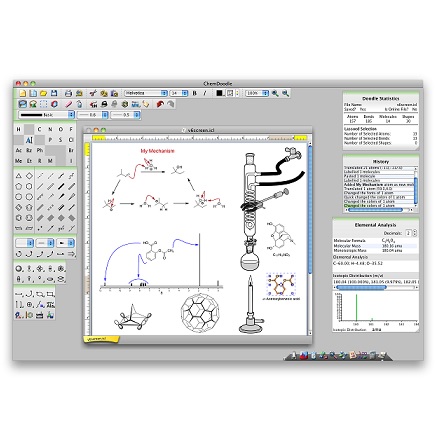

You may still have pages separated on load by changing the settings in the Preferences window, under the Files tab. CDX and CDXML pages are now combined on load by default.This option is enabled by default and can be disabled in the Preferences window, under the Files tab. There is a new CDX and CDXML file option to suppress the load of invisible atoms (no labels or bonds attached).Arc input has been fixed with end points and angles now correctly interpreted, and elliptical arcs are input as well. Isotope mass values are no longer added for deuterium and tritium labels, as they are not present in the original render. Much better handling of symbol attributes.

Text placement has been made much more accurate, including rotated text. Improved adherence to double bond orientations. Better support for all kinds of arrows, including bold, equilibrium and retrosynthetic also improved arrowhead sizing.
#Chemdoodle pdf#
CDX and CDXML data can now be recovered from EMF and PDF files, regardless of operating system, by opening them in ChemDoodle.

#Chemdoodle windows#
You can now copy and paste CDX and CDXML data directly into ChemDoodle on both Windows and macOS.You can finally collaborate with chemists in creating documents even if they use a different operating system. On any operating system you run ChemDoodle on, you will now be able to extract chemical data from Microsoft Office files, even if you do not have access to the original chemical program or Microsoft Office. The ability to scan Microsoft Office documents for chemical data has been completed and is no longer an experimental feature.See section 15.7 of the ChemDoodle 2D User Guide for more information. This works on both Windows and macOS, as long as the original image was embedded on the same operating system. Simply copy the figure in the 3rd party application and paste into ChemDoodle to recover the original drawing for further editing.
#Chemdoodle software#

I would like for it to render (say the caffeine molecule) as flat 2D circles, and for the double bonds to be, I don't know, a thicker line of a different color than the single bonds, sort of like this image (but without any borders around the flat colored circles, and I don't need the colored lines divided into two pieces necessarily): I am following this documentation for ChemDoodle to generate a 2D rendering of a molecule.


 0 kommentar(er)
0 kommentar(er)
